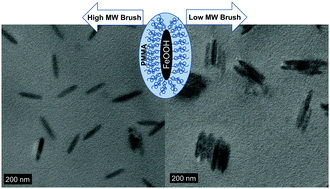Dispersion of PMMA-grafted, mesoscopic iron-oxide rods in polymer films
Abstract
This study investigates the parameters that affect the dispersion of polymer grafted mesoscopic iron-oxide rods (FeMRs) in polymer matrices. FeMRs (212 nm long by 36 nm in diameter) are grafted with poly(methyl methacrylate) (PMMA) at three different brush molecular weights: 3.7 kg mol−1, 32 kg mol−1, and 160 kg mol−1. Each FeMR sample was cast in a polymer thin film consisting of either PMMA or poly(ethylene oxide) (PEO) each at a molecular weight much higher or much lower than the brush molecular weight. We find that the FeMRs with 160 kg mol−1 brush disperse in all matrices while the FeMRs with 32 kg mol−1 and 3.7 kg mol−1 brushes aggregate in all matrices. We perform simple free energy calculations, taking into account steric repulsion from the brush and van der Waals attraction between FeMRs. We find that there is a barrier for aggregation for the FeMRs with the largest brush, while there is no barrier for the other FeMRs. Therefore, for these mesoscopic particles, the brush size is the main factor that determines the dispersion state of FeMRs in polymer matrices with athermal or weakly attractive brush-matrix interactions. These studies provide new insight into the mechanisms that affect dispersion in polymer matrices of mesoscopic particles and therefore guide the design of composite films with well-dispersed mesoscopic particles.


 Please wait while we load your content...
Please wait while we load your content...